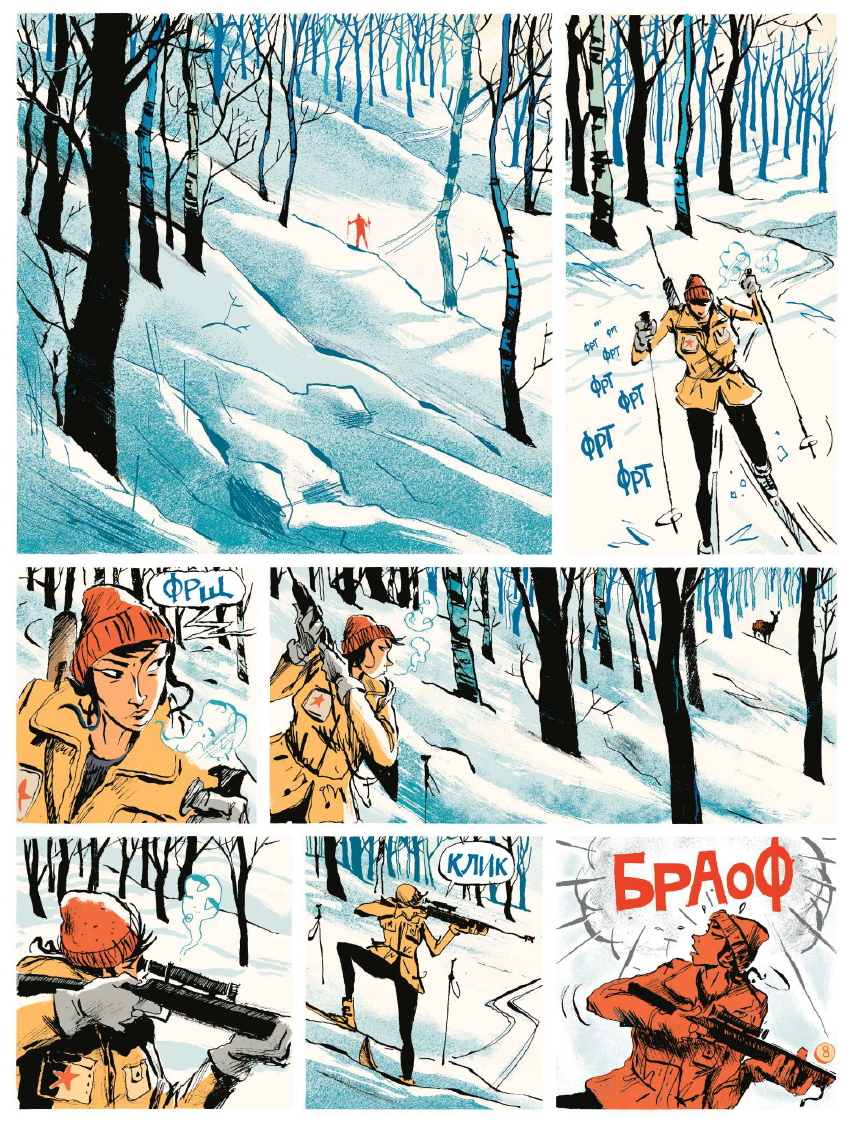A new work from Pierre-Henry Gomont is always a pleasure. After the fumblings of resurrecting a family estate in deepest Africa in Malaterre and an embellished history of the theft of Einstein’s grey matter in Brain Drain, to what subject matter will he turn his considerable talent and style? “Freed from the Communist yoke, Russia was thrown to the wolves of unbridled capitalism,” reads the artist's opening note to Slava, dropping us into the Yeltsin years of the 1990s.

Right from the first pages we’re reminded of Gomont’s wonderful use of color, as a carrier van careens through wintry mountains, highlighted by enticing shades of blue. This tone dominates the book—perhaps not surprisingly, given we’re in northern Russia—but it also pleasingly offsets Gomont’s red sound effects, rendered throughout in Cyrillic. A color long associated with the Soviets, red also appears in the face and scarf of plundering profiteer Lavrin, setting him apart from his surroundings. Lavrin is a new breed, standing out in a yellow coat against the vast grey of a communist city and its citizens - as yet only a middleman, but determined to join the ranks of the rich any way he can. His work ethic, were it not so unethical, might be considered admirable. He’s certainly got hustle. As we begin, Lavrin and his apprentice, the titular Slava Segalov, are driving miles to loot an abandoned Soviet establishment; stripping it, at Lavrin’s insistence, of everything that could possibly be of any value.
Gomont knows the seriousness of this subject matter, but in his introductory note he mentions using “as much lightness as I could muster,” and he does an impeccable job with that. Although detestable, Lavrin’s lack of concern for anything other than profit and power comes across in a big comedic way. Later, two moneymen we see entertaining the thought of financing him, whilst cartoony, are genuinely creepy. Under the sickly sweet veneer of social niceties you can sense huge emanations of evil. From the way their bodies are portrayed to the character of the text, there's a scathing attack on those who ‘love business’ but find physical labor appalling.
Slava, on the other hand, is a more complicated personality. A once-celebrated artist who can no longer find work, it is through him we experience much of the philosophy and emotion of Gomont's story. Like everyone else, he is thrown into this seismic shift between ideologies and their practical, everyday application. But while other characters belong rather clearly to either the old or new ways of life, Slava himself is in flux. He’s navigating new moral dilemmas that have cropped up with the times, thrust onto him and greatly complicated by both his mentor Lavrin and the need for survival.
Following a shootout with rival looters, we are introduced to Nina, a beautiful young woman quite handy with a gun, and her bear-like father, Volodya, who has a penchant for roaming around in his underwear. This is true whether it be in freezing northern forests or a happening rock club in the city; unaffected by the elements, his fortitude conveys the strength of the Russian people and how familiar they are with hardship. Conversely, while dressed up in a tuxedo and ordered to be silent at all costs as the group attend an opulent party, his imposing figure commands respect, albeit played for many laughs.
Volodya’s insistence on his kin being “survivors” brings us to the crux of the story. The mine where they have labored their entire lives is being sold off, and the workers bring Lavrin and Slava in to see what can be done. Although never given a full page of its own, every panel depicting the mine's edifice carries a certain power, aided by Gomont's beautiful nocturnal blues. It is structures like these on which the Russians have built their society, and while their fates are still to be determined, the buildings loom large over the proceedings. Oblivious to the disdain about to be heaped upon him for doing so, Lavrin launches into a lengthy, adulatory explanation of the process of asset stripping, so beloved of hedge funds today. The gusto with which he jumps about the page describing the details–nicely portrayed in reds and blues–is actually quite chilling. This scene is shortly followed by more comic relief, as Slava laments: “It’s a bad sign when accountants are getting the hot chicks.”
Thus the miners are ushered into the modern age, as they try to save their workplace of so many years. Very quickly it becomes apparent that they need to dance with these new devils and adopt their strategies in order to have any chance of retaining the old way of life. The story is concise–one gets the sense Gomont could have really drawn this out if he wanted to–but compelling, its ending both dreadful and ambiguous. Just like its real life counterpart.
The post Slava: After The Fall appeared first on The Comics Journal.


No comments:
Post a Comment